
The 1st Cavalry Division is a combined arms division and is one of the most decorated combat divisions of the United States Army. It is based at Fort Cavazos, Texas. It was formed in 1921 and served during World War II, the Korean War, the Vietnam War, the Persian Gulf War, with the Stabilization Force in Bosnia and Herzegovina, the Iraq War, the War in Afghanistan as well as Operation Freedom's Sentinel and Operation Inherent Resolve. As of July 2023, the 1st Cavalry Division is subordinate to the III Armored Corps and is commanded by Major General Thomas M. Feltey.

The Indonesian Army is the land branch of the Indonesian National Armed Forces. It has an estimated strength of 300,400 active personnel. The history of the Indonesian Army has its roots in 1945 when the Tentara Keamanan Rakyat (TKR) "People's Security Army" first emerged as a paramilitary and police corps.
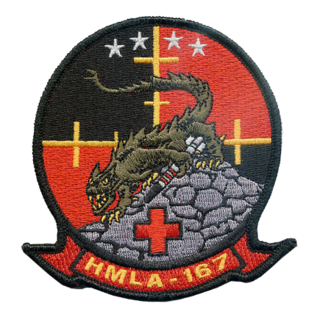
Marine Light Attack Helicopter Squadron 167 (HMLA-167) is a United States Marine Corps helicopter squadron consisting of Bell AH-1Z Viper attack helicopters and UH-1Y Venom utility helicopters. Known as the "Warriors", they are based at Marine Corps Air Station New River, North Carolina and fall under the command of Marine Aircraft Group 29 (MAG-29) and the 2nd Marine Aircraft Wing.
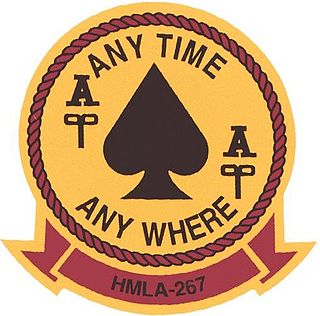
Marine Light Attack Helicopter Squadron 267 (HMLA-267) is a United States Marine Corps helicopter squadron consisting of Bell AH-1Z Viper attack helicopters and Bell UH-1Y Venom utility helicopters. Nicknamed the "Stingers", the squadron is based at Marine Corps Air Station Camp Pendleton in California, and falls under the command of Marine Aircraft Group 39 (MAG-39) and the 3rd Marine Aircraft Wing.

Marine Light Attack Helicopter Squadron 369 (HMLA-369) is a United States Marine Corps helicopter squadron consisting of AH-1Z Viper attack helicopters and UH-1Y Venom utility helicopters. The squadron, also known as the "Gunfighters", is based at Marine Corps Air Station Camp Pendleton in California and falls under the command of Marine Aircraft Group 39 (MAG-39) and the 3rd Marine Aircraft Wing.
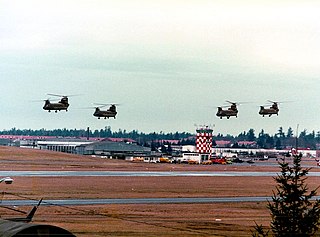
Gray Army Airfield, also known as Gray AAF, is a military airfield located within Joint Base Lewis–McChord near Tacoma, in Pierce County, Washington, United States.

Marine Light Attack Helicopter Squadron 269 (HMLA-269) is a United States Marine Corps helicopter squadron consisting of AH-1Z Viper attack helicopters and UH-1Y Venom utility helicopters. Also known as "The Gunrunners", the squadron is based at Marine Corps Air Station New River in North Carolina and fell under the command of Marine Aircraft Group 29 (MAG-29) and the 2nd Marine Aircraft Wing.
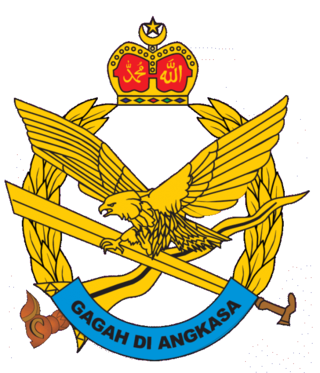
The Malaysian Army Aviation is the army aviation branch of the Malaysian Army. Currently equipped with helicopters in the liaison, transport and light attack roles. The Malaysian Army also plans to equip PUTD with dedicated attack helicopters in support of Malaysian Army units.

Marine Aircraft Group 41 (MAG-41) is a United States Marine Corps reserve aviation unit based at Naval Air Station Joint Reserve Base Fort Worth, Texas that is currently composed of one F/A-18C squadron, one KC-130J squadron, one C-40 squadron, two Northrop F-5 aggressor squadron based at Marine Corps Air Station Yuma, Arizona and Marine Corps Air Station Beaufort, South Carolina, one Marine Light Attack Helicopter Squadron at MCAS Camp Pendleton, one MV-22B squadron based at MCAS Miramar, one aviation logistics squadron and two wing support squadrons with multiple detachments throughout the United States.
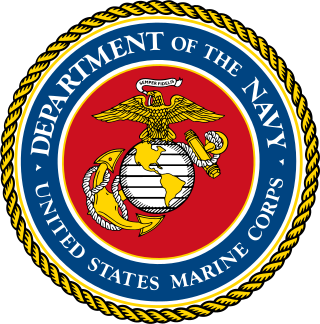
The United States Marine Corps is organized within the Department of the Navy, which is led by the Secretary of the Navy (SECNAV). The most senior Marine commissioned officer is the Commandant of the Marine Corps, responsible for organizing, recruiting, training, and equipping the Marine Corps so that it is ready for operation under the command of the unified combatant commanders. The Marine Corps is organized into four principal subdivisions: Headquarters Marine Corps, the Operating Forces, the Supporting Establishment, and the Marine Forces Reserve.

The United States Marine Corps Aviation (USMCA) is the aircraft arm of the United States Marine Corps. Aviation units within the Marine Corps are assigned to support the Marine Air-Ground Task Force, as the aviation combat element, by providing six functions: assault support, antiair warfare, close air support, electronic warfare, control of aircraft and missiles, and aerial reconnaissance. The Corps operates rotary-wing, tiltrotor, and fixed-wing aircraft mainly to provide transport and close air support to its ground forces. Other aircraft types are also used in a variety of support and special-purpose roles. All Marine Corps aviation falls under the influence of the Deputy Commandant for Aviation, whose job is to advise the Commandant of the Marine Corps in all matters relating to aviation, especially acquisition of new assets, conversions of current aircraft, maintenance, operation, and command.

Pondok Cabe Airport is a combined civilian and military airport in Pondok Cabe, Pamulang, South Tangerang, Banten, Indonesia. The airport is owned by the state oil company Pertamina and operated by Pelita Air Service, which also owned Indopelita Aircraft Services that has a maintenance hangar at this airport. Pondok Cabe does not handle regular airline traffic. Other than serving as the Maintenance, repair and overhaul base for Pelita Air Service and PT. Indonesia Defence Services, the airport is also the home of the Aviation Wing of the Indonesian National Police, CASA 212 equipped- Multipurpose air squadron of the Indonesian Army (Puspenerbad) and Naval Aviation (Puspenerbal) of Indonesian Navy as well as Portela Jaya Light-sport aircraft hangar.

Marine Light Attack Helicopter Squadron 467 (HMLA-467) was a United States Marine Corps helicopter squadron consisting of AH-1W SuperCobra attack helicopters and UH-1Y Venom utility helicopters. The squadron, nicknamed the "Sabers", was based at Marine Corps Air Station New River, North Carolina and was under the command of Marine Aircraft Group 29 (MAG-29) and the 2nd Marine Aircraft Wing. The squadron's aircraft markings are grey & white stripes on the aircraft tail to replicate the tail markings on a Diamondback Rattlesnake and the markings on the lighthouses in North Carolina.
Combat arms are troops within national armed forces who participate in direct tactical ground combat. In general, they are units that carry or employ weapons, such as infantry, cavalry, and artillery units. The use of multiple combat arms in mutually supporting ways is known as combined arms. In some armies, notably the British Army and Canadian Army, artillery and combat engineer units are categorized as combat support, while in others, such as the U.S. Army, they are considered part of the combat arms. Armored troops constitute a combat arm in name, although many have histories derived from cavalry units.
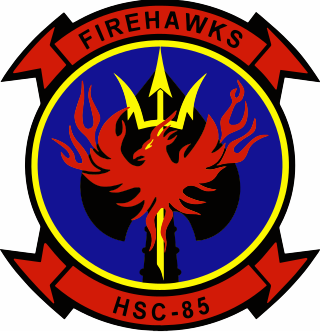
Helicopter Sea Combat Squadron EIGHT FIVE (HSC-85) was a United States Navy Reserve forces helicopter squadron (RESFORON) based out of Naval Air Station North Island in San Diego, California. The "FIREHAWKS" of HSC-85 are Reserve and Active Component Sailors who operate and maintain Sikorsky MH-60S Seahawk helicopters.

The 17th Aviation Brigade was a military formation of the United States Army. It was originally activated at Nha Trang, Vietnam, as the 17th Aviation Group (Combat) on 15 December 1965 under the 1st Aviation Brigade. Later it moved to Tuy Hoa in November 1970 and then to Pleiku in January 1972. The group had the mission of commanding and controlling all non-divisional assets in II Corps Tactical Zone, under I Field Force. The 10th, 14th, 52d, 223rd and 268th Aviation Battalions as well as the 7th Squadron, 17th Cavalry served with the group.
A Combat aviation brigade (CAB) is a multi-functional brigade-sized unit in the United States Army that fields military helicopters, offering a combination of attack/reconnaissance helicopters, medium-lift helicopters, heavy-lift helicopters, and MEDEVAC capability.

A squadron in an air force, or naval or army aviation service, is a unit comprising a number of military aircraft and their aircrews, usually of the same type, typically with 12 to 24 aircraft, sometimes divided into three or four flights, depending on aircraft type and air force.

The Khmer Air Force, commonly known by its americanized acronym KAF was the air force component of the Khmer National Armed Forces (FANK), the official military of the Khmer Republic during the Cambodian Civil War between 1970 and 1975.

The United States Army Special Operations Aviation Command (USASOAC) provides command and control, executive oversight, and resourcing of U.S. Army Special Operations Command (USASOC) aviation assets and units in support of national security objectives. USASOAC is responsible for service and component interface; training, doctrine, and proponency for Army Special Operations Aviation (SOA); system integration and fleet modernization; aviation resource management; material readiness; program management; and ASCC oversight. USASOAC was established 25 March 2011 consisting of 135 headquarters soldiers and subordinate units totaling more than 3,300 personnel, include the 160th Special Operations Aviation Regiment (Airborne), (160th SOAR (A)) which features 4 Aviation Battalions, the USASOC Flight Company, the Special Operations Aviation Training Battalion, the Systems Integration Management Office, and the Technology Application Projects Office. The first commander of USASOAC was Brig Gen. Kevin Mangum.


































